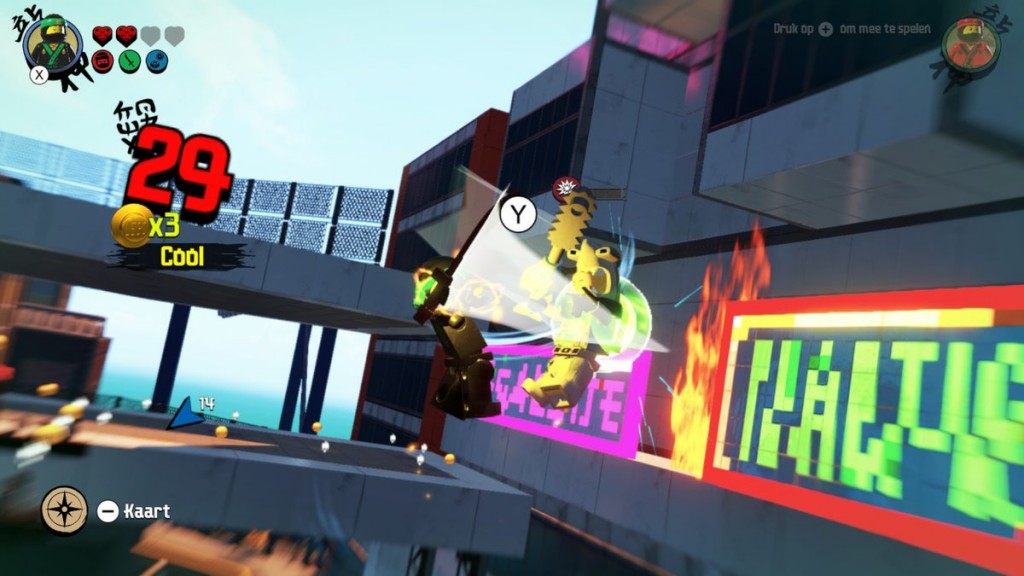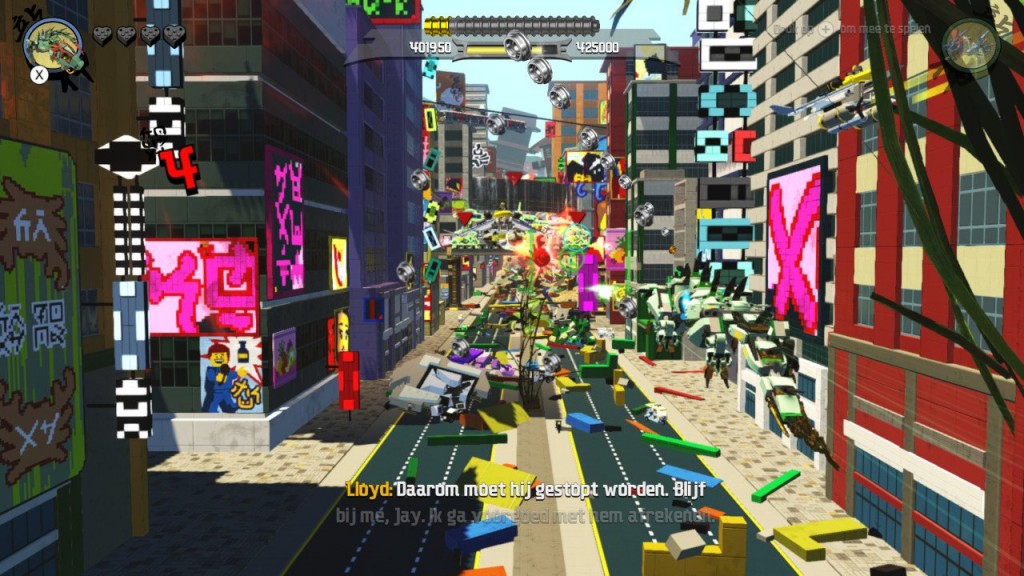Another year, another LEGO video game made by Traveller’s Tales that gets released on a wide variety of platforms. This time, TT has made a video game adaption of The LEGO Ninja Movie that’s currently in theaters. The game follows the story of the movie and the gameplay formula of previous LEGO games.
If you aren’t familiar with the modern LEGO video game formula, here’s a short explanation. The gameplay is focused at gamers of a younger age and is thus pretty simple. You basically run through several levels that are centered around a specific theme (like Star Wars, DC Comics or LEGO Ninjago in this case). The goal of each level is simple: get to the end of the level while solving puzzles and defeating bosses. You also collect LEGO studs, which are the in-game currency used to buy characters, upgrades and cheats. Completing levels and collecting certain hidden objects reward you with golden bricks, which you have to collect to unlock bonus levels. So basically, the gameplay can be best described as a collectathon that is set in a LEGO universe.

Not enough improvement
If you have played almost every modern LEGO video game, you’ll probably have noticed by now that the gameplay stays pretty much the same across all the titles in the franchise. LEGO Ninjago is, sadly, not much different. Traveller’s Tales tries to change the formula up a bit by improving the combat, or so they claim. While it’s true that the combat in LEGO Ninjago looks flashier, the actual mechanics are still the same. You still have one attack button that you constantly have to spam to mow through your opponents. A stunned enemy can still be defeated with a flashy move, although you now have to rapidly attack the stunned enemy to finish him off, instead of pressing the button once to activate a finishing move. The only seemingly new mechanic is the token system that lets you tweak your attacks with modifiers like gaining a heart after defeating a stunned enemy or longer combo chains. You earn these tokens by simply progressing the story. At first, this may seem like something new, but these modifiers were also in previous LEGO games, with the difference being they had to be activated as cheats.

There’s also not much improvement to be found outside of the combat system. Solving puzzles is still as easy as always and comes down to either building something by holding down the interaction button or using the right character to activate a switch. There was never a moment where I had to think for a second in order to solve a puzzle. Yes, these games are primarily made for young children so these games are made easy on purpose. But that doesn’t mean there doesn’t have to be any form of challenge in a game. What’s the use of a puzzle if it basically solves itself? I’m not asking Traveller’s Tales to make the next LEGO game like Portal or other challenging games, but they should take some notes from other games made primarily for children like Ratchet and Clank or the Super Mario series.
Sometimes a visual mess
While I wished the gameplay would’ve been improved in LEGO Ninjago, it’s not a big issue for me. The gameplay, while simple, is still pretty solid and easy. However, I do have a big issue with a particular type of gameplay sections that are spread throughout the game. The vehicle sections in LEGO Ninjago are a visual mess. They play as an on-rails shooter but are visually so horribly designed that they are easily the worst part of the game. When you’re controlling your vehicle, the screen is filled with conflicting colors and way too many things happening at the same time. I often didn’t see the enemies I had to shoot until they almost passed me, making it look like they popped up out of nowhere. The game also expects from you to pay constant attention to the UI while going through this chaotic mess, which results in an even more cluttered screen. It’s a good thing that there are only a few sections like this in the entire game, otherwise, I would’ve just stopped playing.

Technical issues
Another problem that I have with LEGO Ninjago is how badly it runs on almost every system. The game suffers from framerate drops and audio issues, making LEGO Ninjago an unpleasant video game experience. Whenever there were a lot of objects on screen (like in the vehicle sections), the framerate often dropped below 10 fps, which is outright terrible for a game made by a developer who has more than 10 years of experience with this type of game. Luckily, these frame drops didn’t occur too much during my playthrough (about once every 30 minutes). But then there’s also the audio that seems to have some problems. Some of the spoken dialogue often gets repeated right after hearing it for the first time, or sometimes simply doesn’t play at all. It doesn’t ruin the game per se, but it does make it more difficult to justify the €50-60 price tag for the console versions. If you want to check out this game, I’d recommend getting the pc version. It’s the cheapest (€30) and seems to suffer the least from these technical issues.
Conclusion
The LEGO Ninjago Movie Video Game is simply another LEGO game that follows the same gameplay formula that can be found in all other modern LEGO games made by Traveller’s Tales. It doesn’t actually improve anything in a major way and suffers from technical issues and horribly designed vehicle sections. Still, if you like the core gameplay of LEGO games, then you’ll probably be able to enjoy this title. Just don’t expect anything new and prepare for some frame drops.

